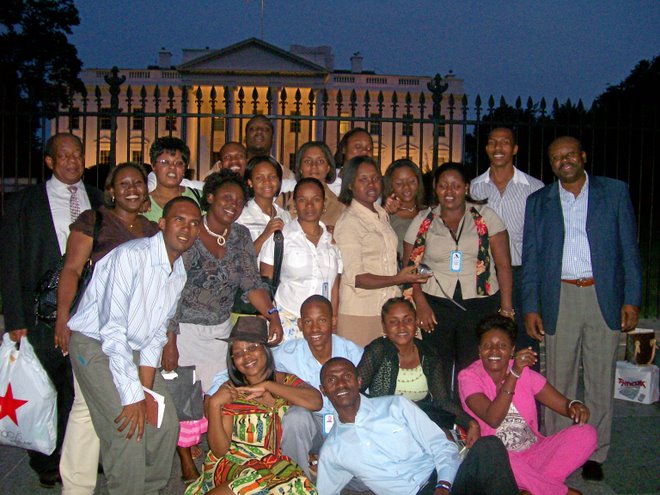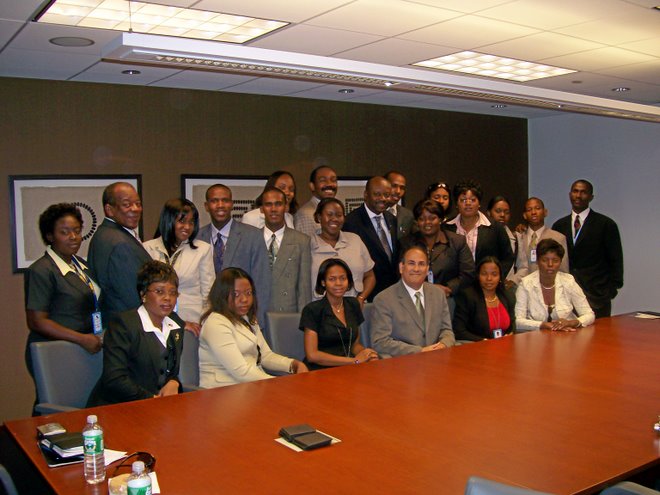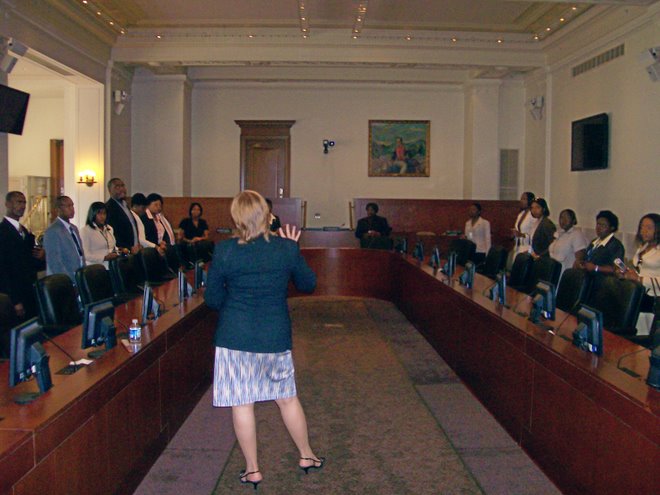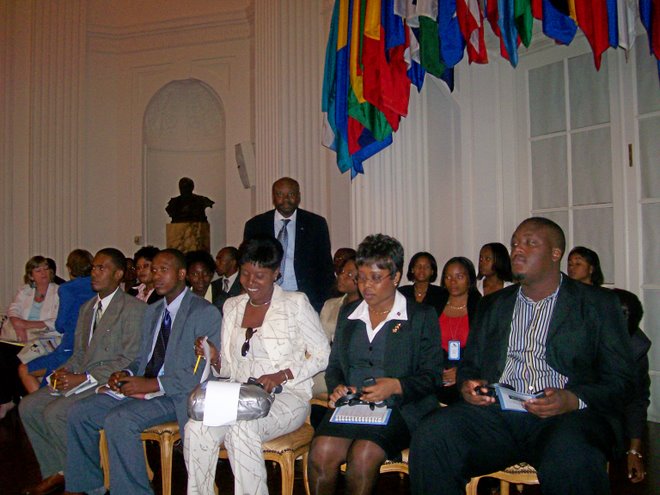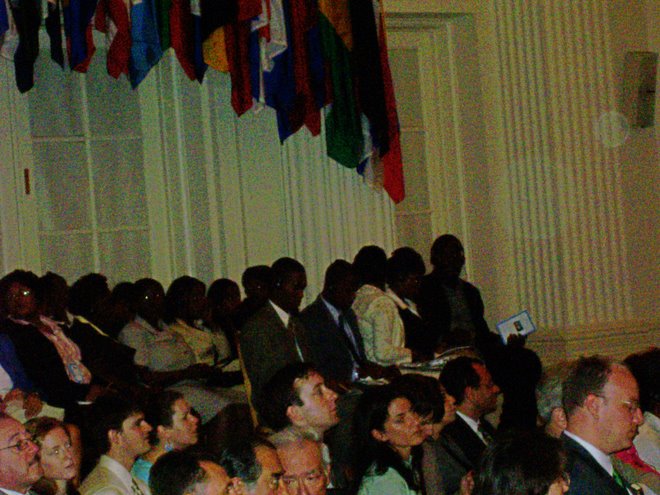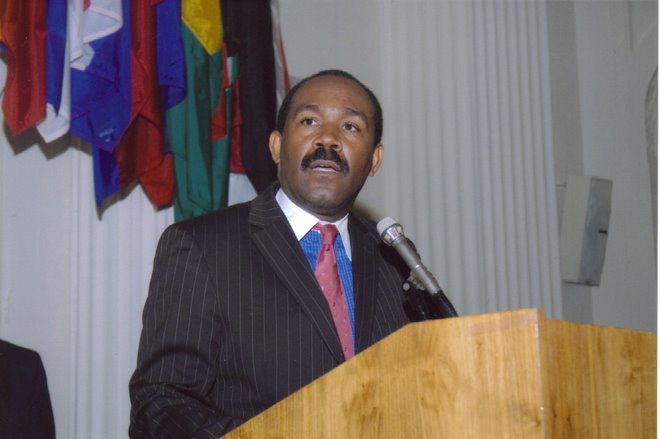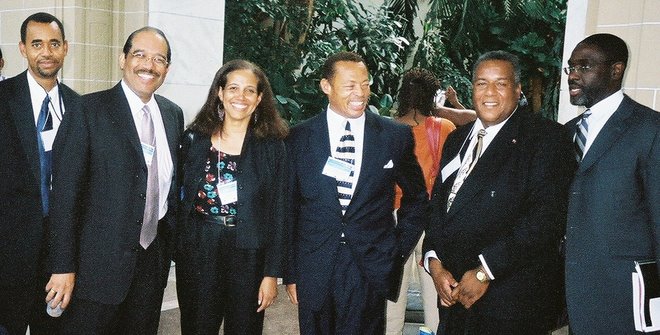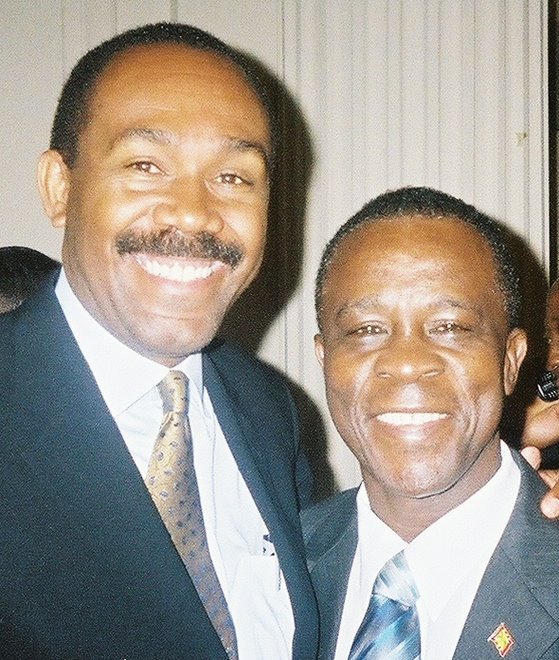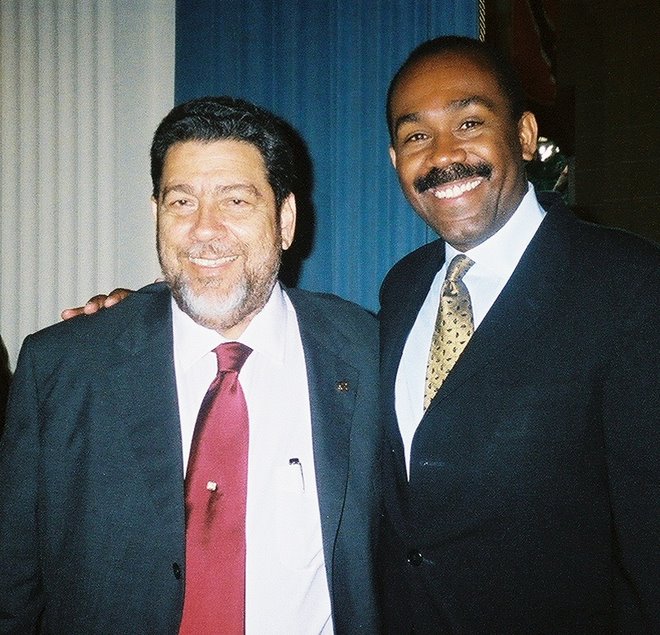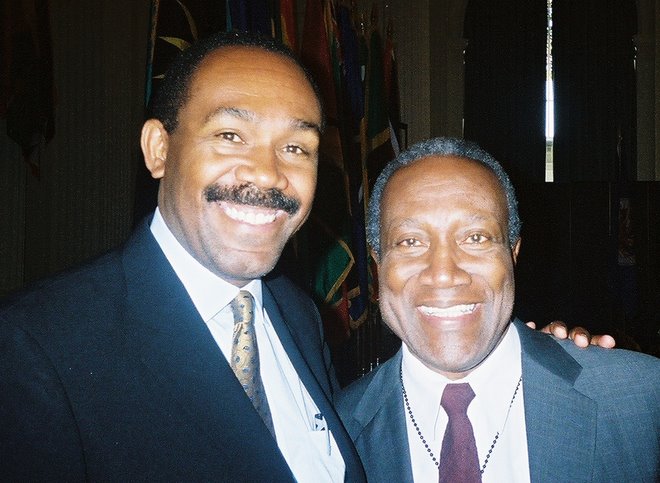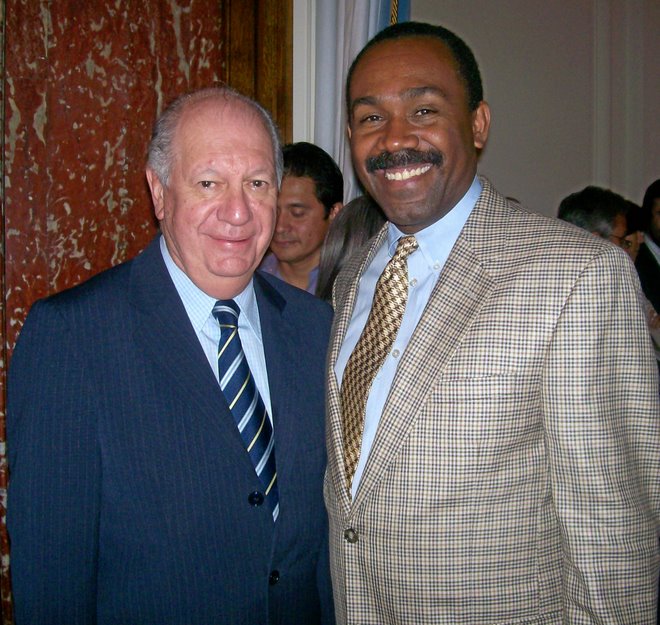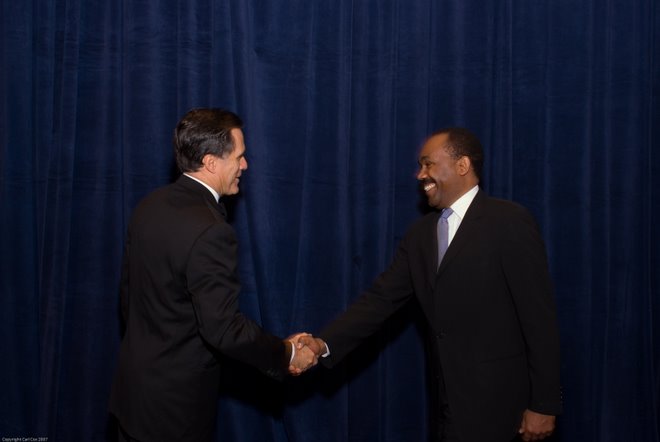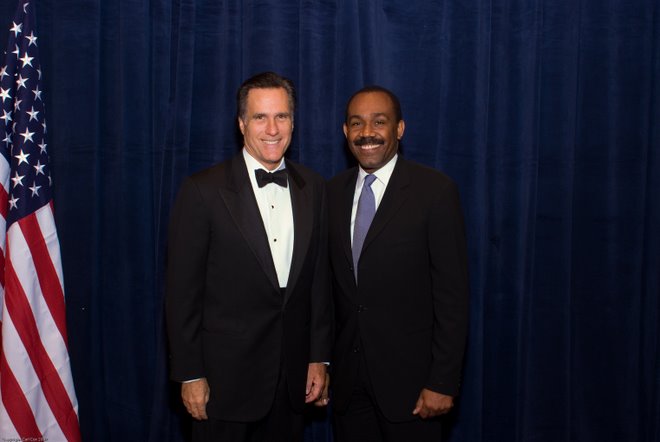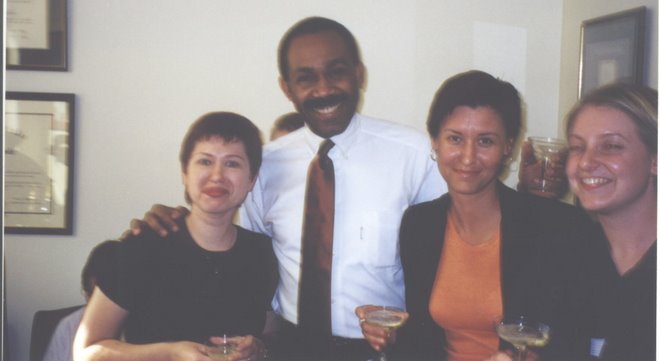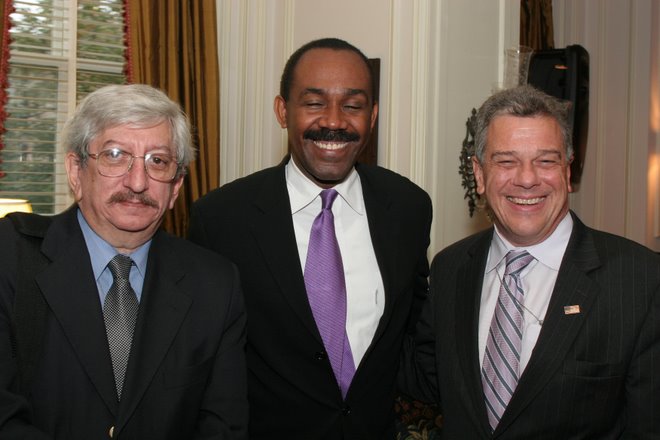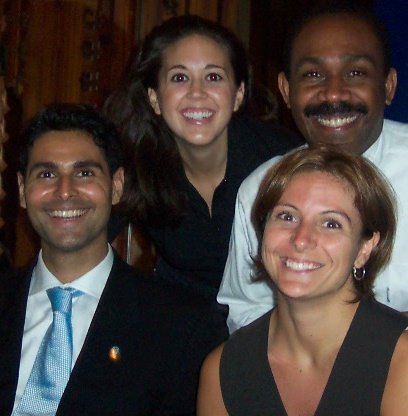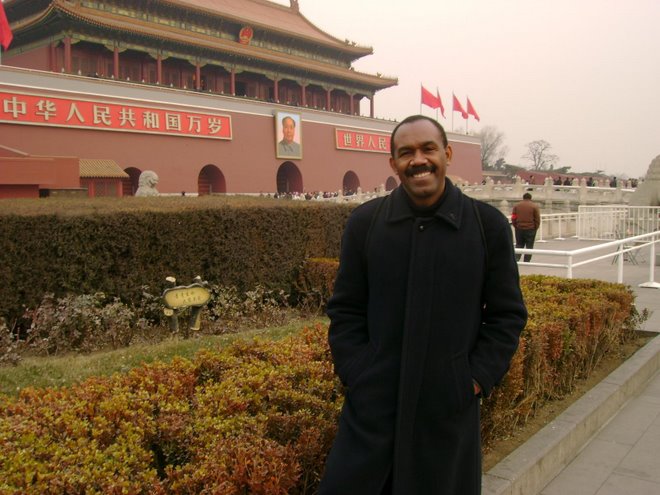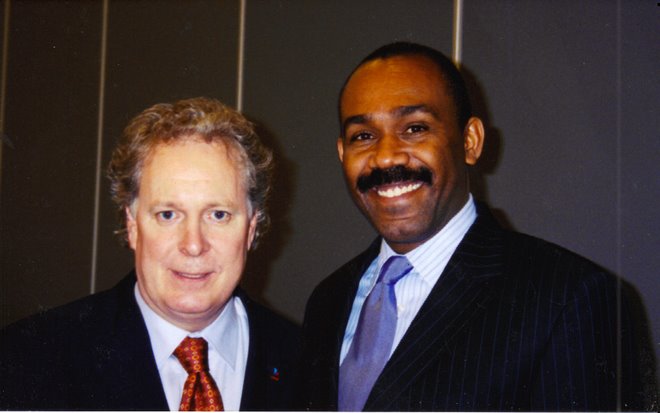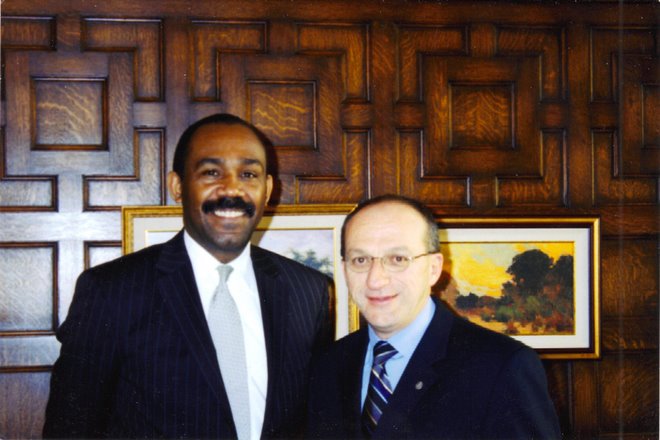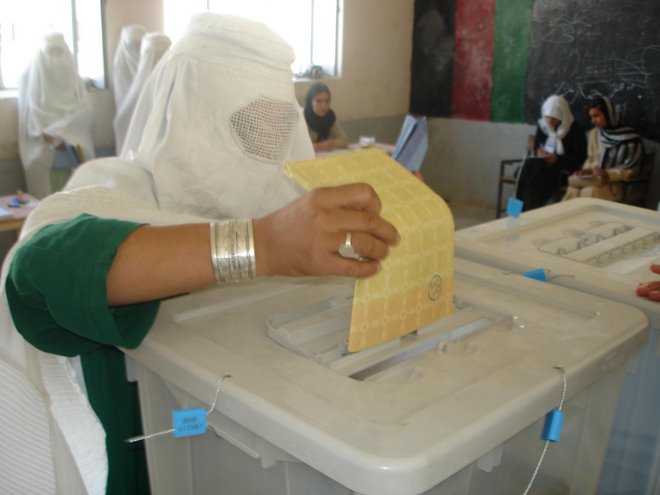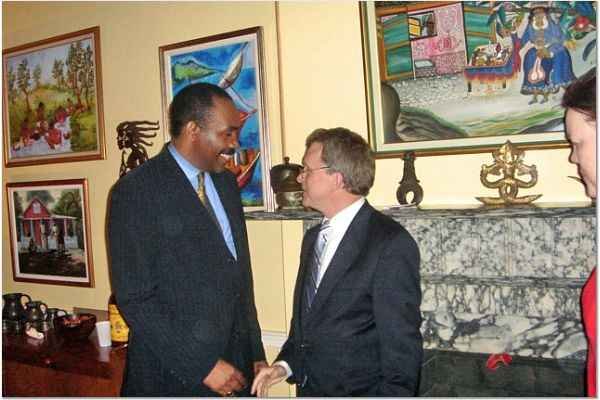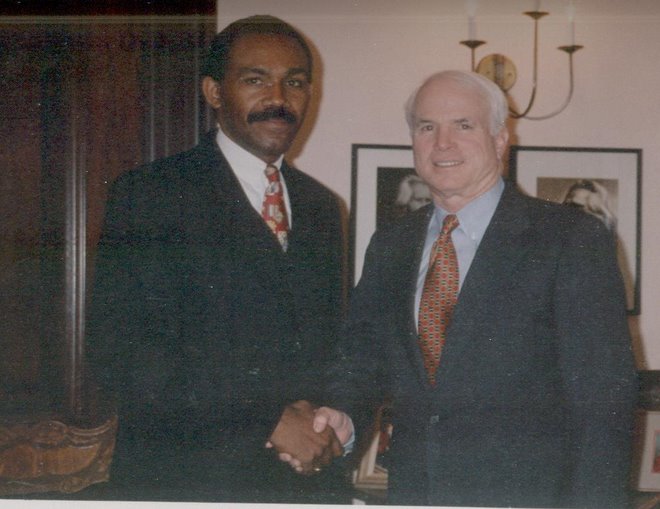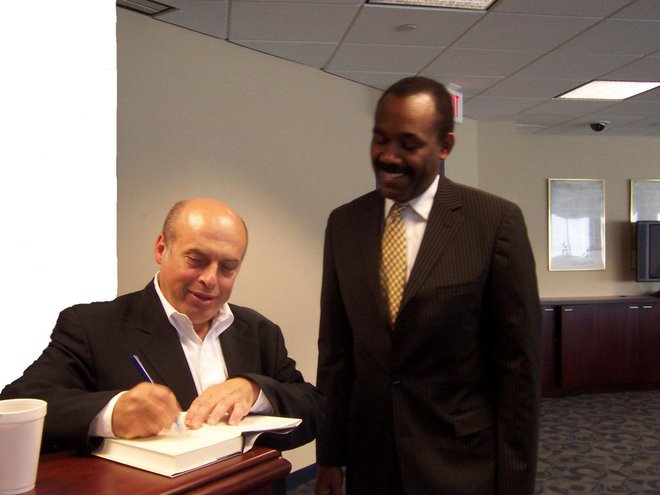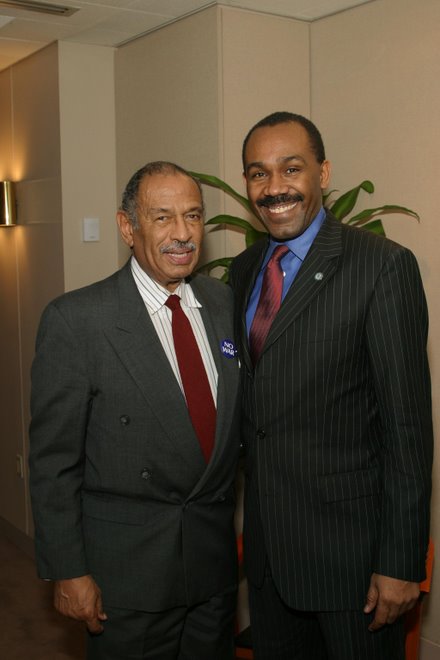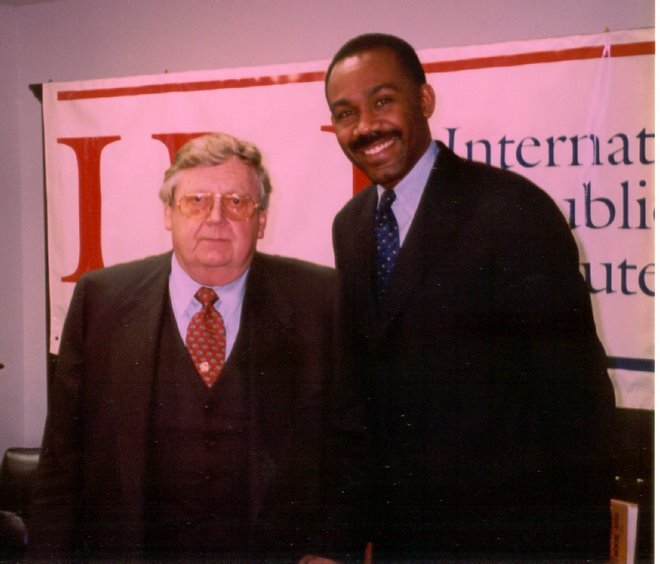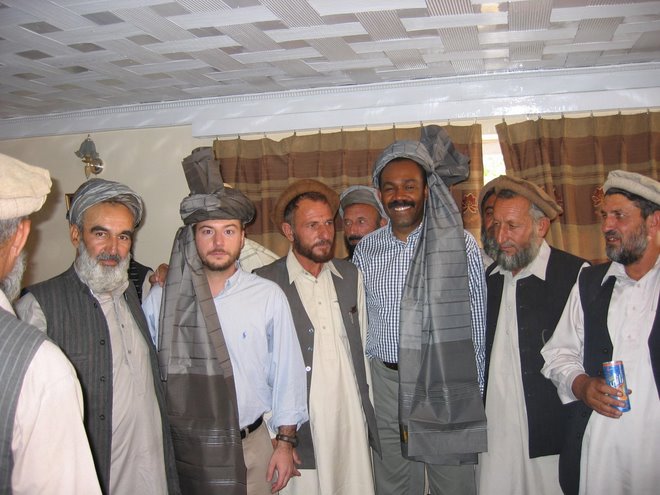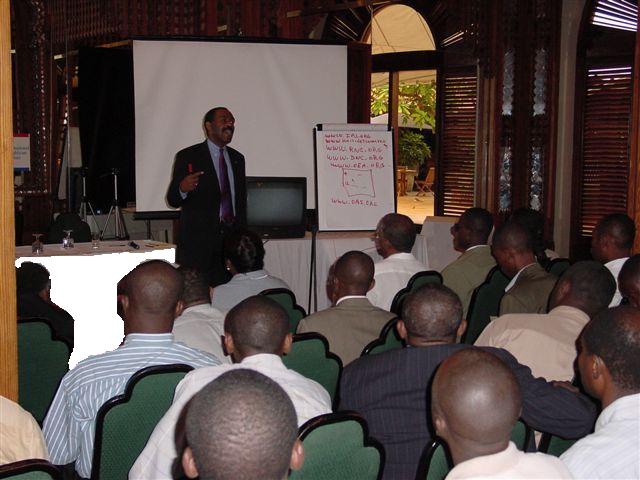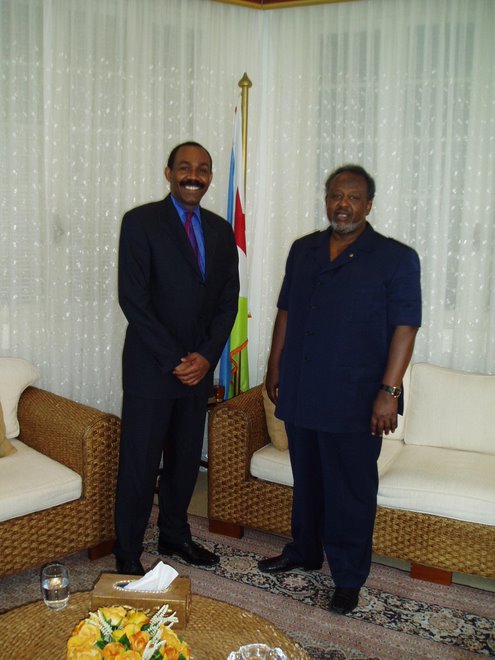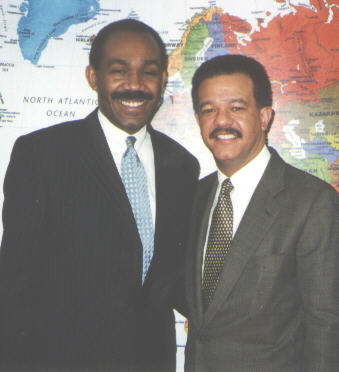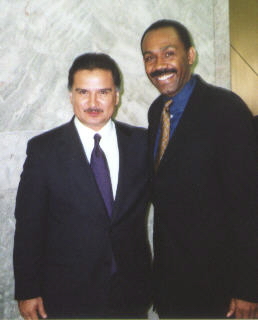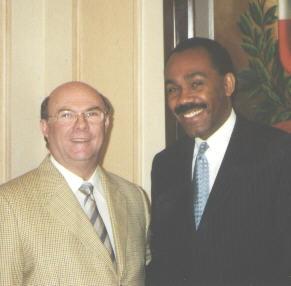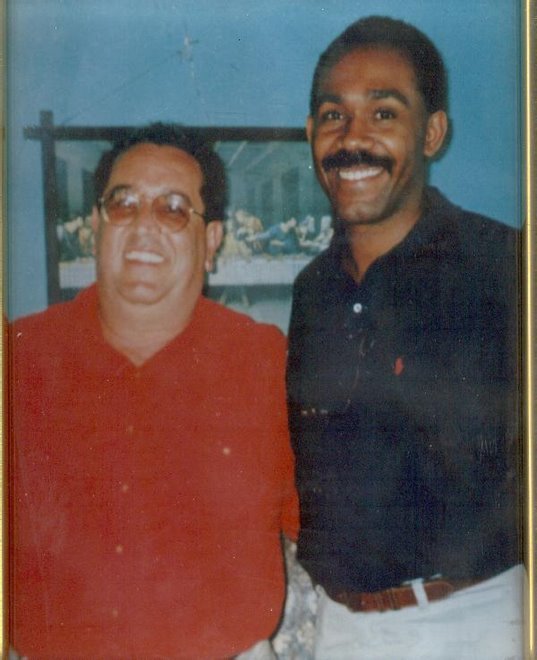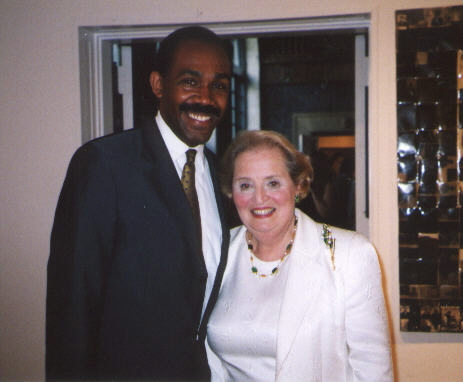By
 Roger F. Noriega - Visiting fellow at AEI Washington, DC. While the world's attention is focused on a struggling Iraq and a rising China, a battle for the heart and soul of the Americas is being waged closer to home. A simplistic account might describe this confrontation as a tug of war between U.S. president George W. Bush's vision and that of his self-appointed nemesis, Venezuelan president Hugo Chávez. Equally misleading are characterizations that describe the showdown as one between left and right, rich and poor, north and south. But this is not a battle between two powerful leaders or between ideologies of the left and right. The contest being waged in the Western Hemisphere is about democracy itself: can it deliver the goods for impatient publics? On one side are leaders from the left and right who see democratic institutions and the rule of law as indispensable to prosperity and liberty. On the other are those who treat democracy as an inconvenience and see free markets as a threat. Twenty-five years ago, about half of the nations in the Western Hemisphere were governed by military dictatorships or authoritarian governments. Today, democracy is gradually taking root in most countries there. For example, by the end of 2007, national elections will have been held in over a dozen of the thirty-four nations in the Western Hemisphere. Just because elections are being held does not mean that everything is progressing smoothly. In fact, in almost all of these nations, people are contending with grave problems, and democracy is being sorely tested. For example, in \nIn Venezuela, one-time coup leader Chávez won the presidency in 1998 and has since retained power through a series of increasingly undemocratic ballots. He leads his opponent in the opinion polls running up to the December 3 presidential elections. He has used his political clout to concentrate all the powers of the state in his hands, to attack dissenting voices, and to rig the electoral apparatus in his favor. \nIn Nicaragua, unreconstructed Sandinista dictator Daniel Ortega recently won an election under rules rigged through a cynical deal with corrupt former president Arnoldo Alemán. Ortega owes his victory to Alemán's maneuver to split the democratic vote. But the fact remains that three democratically elected governments failed to address the poverty that grips Nicaragua, and Ortega's victory is testament to that failure. \nAlthough elections are extraordinarily important--and are sometimes essential to addressing deep-seated tension--they are not an end in themselves. Without functioning democratic institutions--such as independent judiciaries, honest and transparent electoral systems, and responsive government agencies--and effective civic societies, the promise of self-government cannot be fully realized. Building these institutions takes time. In the absence of strong institutions, elections can be manipulated by populist leaders to win power from impatient populations. When these populists use that power to dismantle democratic institutions, the weakest among us--who might have supported these demagogues, hoping for quick and simple solutions--find themselves at the mercy of a swaggering strongman. ",1] ); //--> Bolivia, early presidential elections were held in 2005 because the previous three presidents were toppled by a mob led by Evo Morales, not coincidentally the man who won power and became Bolivia's president. Morales is now seeking to reengineer the very institutions under which he was elected to satisfy his ambitions for social revolution. In Venezuela, one-time coup leader Chávez won the presidency in 1998 and has since retained power through a series of increasingly undemocratic ballots. He leads his opponent in the opinion polls running up to the December 3 presidential elections. He has used his political clout to concentrate all the powers of the state in his hands, to attack dissenting voices, and to rig the electoral apparatus in his favor. In Nicaragua, unreconstructed Sandinista dictator Daniel Ortega recently won an election under rules rigged through a cynical deal with corrupt former president Arnoldo Alemán. Ortega owes his victory to Alemán's maneuver to split the democratic vote. But the fact remains that three democratically elected governments failed to address the poverty that grips Nicaragua, and Ortega's victory is testament to that failure. Although elections are extraordinarily important--and are sometimes essential to addressing deep-seated tension--they are not an end in themselves. Without functioning democratic institutions--such as independent judiciaries, honest and transparent electoral systems, and responsive government agencies--and effective civic societies, the promise of self-government cannot be fully realized. Building these institutions takes time. In the absence of strong institutions, elections can be manipulated by populist leaders to win power from impatient populations. When these populists use that power to dismantle democratic institutions, the weakest among us--who might have supported these demagogues, hoping for quick and simple solutions--find themselves at the mercy of a swaggering strongman. \nCan Institutions Make the Difference? Today, many Latin American nations have entered the twenty-first century with weak and ineffective institutions of government. While some countries enjoy a democratic tradition dating back more than a century, their governments and civil societies have not kept pace with the radical changes ushered in during the last half century. Boom-and-bust economic cycles, new demands for social justice stirred by democracy itself, and the weight of persistent poverty have left most governments in Latin America struggling to meet their essential responsibilities. \nThe good news is that throughout the region in the last twenty-five years, the peoples of the Americas have clamored for more democracy, not less. Only Cuba followed the trail to nowhere blazed by Fidel Castro. And, gradually, the military dictatorships that struggled to maintain stability gave way to democratically elected alternatives. The elections that followed have produced political leadership of the people's choosing. Unfortunately, not all of these governments have performed responsibly, and corruption and unaccountable institutions have left many citizens further estranged from their governments. A full regimen of free-market reforms has been adopted in only a handful of nations, leaving the job half finished and the people wholly disenchanted. \nWhile many countries in Latin America have improved their macroeconomic climates with reforms, sustained and equitable growth requires that governments follow through on second-generation reforms and, in particular, establishing the rule of law. Research shows that the rule of law and effective governance are fundamental to growth--and, on that score, most Latin American countries are not keeping up with the quickening global pace. Of the 208 countries surveyed in the World Bank Governance Matters project, only three countries in Latin America (",1] ); //--> Can Institutions Make the Difference? Today, many Latin American nations have entered the twenty-first century with weak and ineffective institutions of government. While some countries enjoy a democratic tradition dating back more than a century, their governments and civil societies have not kept pace with the radical changes ushered in during the last half century. Boom-and-bust economic cycles, new demands for social justice stirred by democracy itself, and the weight of persistent poverty have left most governments in Latin America struggling to meet their essential responsibilities. The good news is that throughout the region in the last twenty-five years, the peoples of the Americas have clamored for more democracy, not less. Only Cuba followed the trail to nowhere blazed by Fidel Castro. And, gradually, the military dictatorships that struggled to maintain stability gave way to democratically elected alternatives. The elections that followed have produced political leadership of the people's choosing. Unfortunately, not all of these governments have performed responsibly, and corruption and unaccountable institutions have left many citizens further estranged from their governments. A full regimen of free-market reforms has been adopted in only a handful of nations, leaving the job half finished and the people wholly disenchanted. While many countries in Latin America have improved their macroeconomic climates with reforms, sustained and equitable growth requires that governments follow through on second-generation reforms and, in particular, establishing the rule of law. Research shows that the rule of law and effective governance are fundamental to growth--and, on that score, most Latin American countries are not keeping up with the quickening global pace. Of the 208 countries surveyed in the World Bank Governance Matters project, only three countries in Latin America ( \nEven when comparing these countries with others in their same income brackets, Chile, Uruguay, El Salvador, and Brazil were the only countries in Latin America that fared better than other nations outside the region.[1] Empirical studies have demonstrated that strong institutions are instrumental in helping emerging economies catch up with developed countries. Moreover, according to development studies, strong institutions are more likely to foster growth than geography or even policies. Indeed, several studies have discovered a clear linkage between good governance and economic growth and development.[2] \nDespite a mixed track record in the Americas to date, most leaders of these countries know that they will reach their full potential only when they open up their political systems and economies, guarantee the rule of law, reward merit, extend opportunity to people on the margins so they can help themselves out of poverty, and develop transparent rules of the game and an accountable state that is strong enough to apply these rules without discrimination for the common good. \nThis model cannot, however, be imposed from outside. It must be promoted through democratic processes and institutions because democracy, at its essence, is a very efficient engine for taking power from those who have it and moving it to those who do not. It can work as well in breaking down a 500-year-old caste system in Bolivia as it can in circulating power within the modern politics of the United States. \nMaking Democracy Work by Empowering People At first blush, it might appear that the leftist labor leader and recently reelected Brazilian president Lula da Silva has very little in common with Felipe Calderón, the rightist who became ",1] ); //--> Chile, Costa Rica, and Uruguay) did better than average with regard to the rule of law in 2005. Furthermore, only three countries (El Salvador, Honduras, and Colombia) had higher scores than in 2000. Even when comparing these countries with others in their same income brackets, Chile, Uruguay, El Salvador, and Brazil were the only countries in Latin America that fared better than other nations outside the region.[1] Empirical studies have demonstrated that strong institutions are instrumental in helping emerging economies catch up with developed countries. Moreover, according to development studies, strong institutions are more likely to foster growth than geography or even policies. Indeed, several studies have discovered a clear linkage between good governance and economic growth and development.[2] Despite a mixed track record in the Americas to date, most leaders of these countries know that they will reach their full potential only when they open up their political systems and economies, guarantee the rule of law, reward merit, extend opportunity to people on the margins so they can help themselves out of poverty, and develop transparent rules of the game and an accountable state that is strong enough to apply these rules without discrimination for the common good. This model cannot, however, be imposed from outside. It must be promoted through democratic processes and institutions because democracy, at its essence, is a very efficient engine for taking power from those who have it and moving it to those who do not. It can work as well in breaking down a 500-year-old caste system in Bolivia as it can in circulating power within the modern politics of the United States. Making Democracy Work by Empowering People At first blush, it might appear that the leftist labor leader and recently reelected Brazilian president Lula da Silva has very little in common with Felipe Calderón, the rightist who became \nThe most important common trait of these Brazilian and Mexican leaders is that they waste no time blaming others for their countries' problems. They also share a conviction that defeating poverty by empowering their people is their most urgent task. It could be argued that the success or failure of democracy in Latin America very much depends on the ability of these two leaders to make good on their plan to make democracy work for the poorest of their countrymen. As they validate formulas by which democracy can deliver the goods, governing through institutions and the rule of law will compare favorably to ineffectual populism. \nPractical Programs to Fight Poverty To tackle the chronic poverty that bedevils most Latin nations, Lula and Calderón are committed to expanding novel social programs that extend well beyond the transfer payments favored by populists. For example, conditional cash transfers (CCTs) serve two important objectives: in the short run they provide immediate assistance to very poor families, and in the long run they help develop human capital by conditioning aid on participation in education and health programs. \nUnder Mexico's PROGRESA-Oportunidades program, which was developed during the administration of President Vicente Fox, modest payments are made to the mother of the household. This feature of the program was based on research showing that women are more likely to value investments in a child's education, health, and nutrition. Similar CCT programs have been implemented in thirteen countries in Latin America.[3] Their viability is twofold: in addition to being politically popular by addressing immediate financial needs of a nation's poorest families, these programs are designed to address essential obstacles to long-term development by extending health, nutrition, and education to those who might otherwise be trapped on the margins of society, thus representing a permanent hindrance to economic progress. ",1] ); //--> Mexico's president on December 1. But both are committed democrats who accept strong institutions and pluralism as essential tenets of sound government and both see their task as promoting their nations' ability to compete in the world economy--not to rant against globalization. That puts these very different men on the same side of a raging battle for the future of the Western Hemisphere, pitting them against the irresponsible populism championed by Hugo Chávez and his acolytes in Bolivia, Ecuador, and Nicaragua. The most important common trait of these Brazilian and Mexican leaders is that they waste no time blaming others for their countries' problems. They also share a conviction that defeating poverty by empowering their people is their most urgent task. It could be argued that the success or failure of democracy in Latin America very much depends on the ability of these two leaders to make good on their plan to make democracy work for the poorest of their countrymen. As they validate formulas by which democracy can deliver the goods, governing through institutions and the rule of law will compare favorably to ineffectual populism. Practical Programs to Fight Poverty To tackle the chronic poverty that bedevils most Latin nations, Lula and Calderón are committed to expanding novel social programs that extend well beyond the transfer payments favored by populists. For example, conditional cash transfers (CCTs) serve two important objectives: in the short run they provide immediate assistance to very poor families, and in the long run they help develop human capital by conditioning aid on participation in education and health programs. Under Mexico's PROGRESA-Oportunidades program, which was developed during the administration of President Vicente Fox, modest payments are made to the mother of the household. This feature of the program was based on research showing that women are more likely to value investments in a child's education, health, and nutrition. Similar CCT programs have been implemented in thirteen countries in Latin America.[3] Their viability is twofold: in addition to being politically popular by addressing immediate financial needs of a nation's poorest families, these programs are designed to address essential obstacles to long-term development by extending health, nutrition, and education to those who might otherwise be trapped on the margins of society, thus representing a permanent hindrance to economic progress. \nPresident Lula launched the Bolsa Familia Program (BFP) in October 2003 as a CCT program that targets extremely poor families, conditioning modest payments on the families' availing themselves of essential health and education services. Currently, the BFP benefits just over 11 million families, or over 40 million participants. Its $4 billion in disbursed funds thus far make it the world's largest CCT program.[4] The program started originally as the Bolsa-Escola in 1995, under the administration of President Fernando Henrique Cardoso. In 2003, it was combined with Bolsa Alimentação (a federal nutrition program), Cartão Alimentação (a nutrition card), and Vale-gás (a cooking fuel supplement) to comprise the integrated Bolsa Familia. \nThe BFP targets families with income under $34 a month and provides cash transfers ranging from $5 to $33 a month.[5] To be eligible, all family members must follow up on their health and nutritional statuses, and school-age children must be enrolled in school and meet attendance requirements. Furthermore, all families must participate in nutritional education events offered by federal, state, and local governments. \nBecause it is such a new program, researchers are only now starting to get a sense of the impact it has on poverty, health, and education. Studies on previous programs such as Bolsa-Escola, Bolsa Alimentação, and Programa para Prevenção e Eliminação da Exploração do Trabalho Infantil--an anti-child labor program--suggest that conditional cash transfers increase school attendance and food intake and decrease child labor. \nMexico's PROGRESA-Oportunidades is similar to Brazil's Bolsa Familia in that it has school attendance requirements for children. In addition, all family members must take advantage of free health services and nutritional consultations. PROGRESA-Oportunida",1] ); //--> President Lula launched the Bolsa Familia Program (BFP) in October 2003 as a CCT program that targets extremely poor families, conditioning modest payments on the families' availing themselves of essential health and education services. Currently, the BFP benefits just over 11 million families, or over 40 million participants. Its $4 billion in disbursed funds thus far make it the world's largest CCT program.[4] The program started originally as the Bolsa-Escola in 1995, under the administration of President Fernando Henrique Cardoso. In 2003, it was combined with Bolsa Alimentação (a federal nutrition program), Cartão Alimentação (a nutrition card), and Vale-gás (a cooking fuel supplement) to comprise the integrated Bolsa Familia. The BFP targets families with income under $34 a month and provides cash transfers ranging from $5 to $33 a month.[5] To be eligible, all family members must follow up on their health and nutritional statuses, and school-age children must be enrolled in school and meet attendance requirements. Furthermore, all families must participate in nutritional education events offered by federal, state, and local governments. Because it is such a new program, researchers are only now starting to get a sense of the impact it has on poverty, health, and education. Studies on previous programs such as Bolsa-Escola, Bolsa Alimentação, and Programa para Prevenção e Eliminação da Exploração do Trabalho Infantil--an anti-child labor program--suggest that conditional cash transfers increase school attendance and food intake and decrease child labor. Mexico's PROGRESA-Oportunidades is similar to Brazil's Bolsa Familia in that it has school attendance requirements for children. In addition, all family members must take advantage of free health services and nutritional consultations. PROGRESA-Oportunida \nStudies have found that PROGRESA-Oportunidades has had significant impact in several areas. One group found that the program "significantly increased utilization of public health clinics for preventative care including prenatal care, child nutrition monitoring, and adult checkups. . . . Moreover, there was no reduction in the utilization of private providers, suggesting that the increase in utilization at public clinics was not substituting public care for private care."[8] Not only does PROGRESA-Oportunidades affect service utilization, but children in the program also experience less illness and better health. The program has also strongly diminished the effect of various shocks (such as unemployment of the head of household or natural disasters) on school enrollment.[9] \nBrazil and Mexico also share a commitment to expanding microfinance programs under which the government invests in its people by providing start-up capital to the very poorest. Such programs make the free market work for the poor, helping them lift themselves out of poverty through tiny enterprises that generate and sustain income. They are modeled on the extremely successful microfinanace program launched by the Grameen Bank in Bangladesh in 1976.[10] Few microenterprises have access to capital or other financial services, so their growth is stunted as they rely on expensive informal loans. Governments have come to recognize that extending credit to and facilitating the growth of these microenterprises produces a substantial return on the investment. Although small by definition, these microenterprises are an important engine of economic growth and development. In 1994, for example, "formal micro- and small enterprises accounted for 98 percent of all firms in Brazil, 30 percent of GDP, 44 percent of total employment, and more than 60 percent of urban jobs"[11] (emphasis added). ",1] ); //--> des began in 1997 in poor rural areas and was renamed Oportunidades in 2002, as it was extended to urban areas as well. By 2005, PROGRESA-Oportunidades covered 5 million families (or 24 percent of Mexico's population) and had a budget of $2.8 billion.[6] Monthly transfers currently range from $10.50 to $66 for education plus another $15.50 for food. All told, these government cash transfers typically account for about one-fifth of a poor family's total spending.[7] Studies have found that PROGRESA-Oportunidades has had significant impact in several areas. One group found that the program "significantly increased utilization of public health clinics for preventative care including prenatal care, child nutrition monitoring, and adult checkups. . . . Moreover, there was no reduction in the utilization of private providers, suggesting that the increase in utilization at public clinics was not substituting public care for private care."[8] Not only does PROGRESA-Oportunidades affect service utilization, but children in the program also experience less illness and better health. The program has also strongly diminished the effect of various shocks (such as unemployment of the head of household or natural disasters) on school enrollment.[9] Brazil and Mexico also share a commitment to expanding microfinance programs under which the government invests in its people by providing start-up capital to the very poorest. Such programs make the free market work for the poor, helping them lift themselves out of poverty through tiny enterprises that generate and sustain income. They are modeled on the extremely successful microfinanace program launched by the Grameen Bank in Bangladesh in 1976.[10] Few microenterprises have access to capital or other financial services, so their growth is stunted as they rely on expensive informal loans. Governments have come to recognize that extending credit to and facilitating the growth of these microenterprises produces a substantial return on the investment. Although small by definition, these microenterprises are an important engine of economic growth and development. In 1994, for example, "formal micro- and small enterprises accounted for 98 percent of all firms in Brazil, 30 percent of GDP, 44 percent of total employment, and more than 60 percent of urban jobs"[11] (emphasis added). \nThe government of Brazil launched a pilot micro-finance program in 1997, CrediAmigo, to address the lack of access to microloans in its poor northeastern states. Although small-scale programs had existed prior to the program, CrediAmigo was unique in its scope and in its public-private partnerships. The government worked with domestic and international donors, the Brazilian Central Bank, and the Bank of the Northeast (a regional, state-owned development bank) to establish the collateral, best practices, and facilities to launch what is now the top microfinance institution in Latin America in terms of geographical coverage, number of clients, and depth of outreach.[12] \nCrediAmigo is also unique in that rather than relying on direct public subsidies, it relies only on in-kind donations from the Bank of the Northeast (in the form of the use of its network, know-how, and infrastructure) and on loans from international organizations such as the World Bank. Furthermore, profitability is increasing while administrative costs as a percentage of total loans are decreasing.[13] \nCrediAmigo and similar programs are distinctive in that they do not require any collateral to receive a microloan. Instead, applicants are grouped into "solidarity groups" and each member cross-guarantees the other recipients in his group. Furthermore, the program provides not only microloans, but also business training and consulting services. \nMicrofinance has been an important endeavor for President Fox in Mexico, as well. Under Fox, the Mexican government established the National Program of the Financing of Microenterpreneurs (Programa Nacional de Financimiento al Microempresario, or PRONAFIM) under the secretary of economy. PRONAFIM disburses funds to the microfinance sector, both to general microfinance institutions and to those focusing on microloans to rural women. In addition to funding, PRONAFIM also promotes sharing best practices among microfinance institutions and provides its own technical assistance. Since 2001, the program has granted over 2 million microcredits. ",1] ); //--> The government of Brazil launched a pilot micro-finance program in 1997, CrediAmigo, to address the lack of access to microloans in its poor northeastern states. Although small-scale programs had existed prior to the program, CrediAmigo was unique in its scope and in its public-private partnerships. The government worked with domestic and international donors, the Brazilian Central Bank, and the Bank of the Northeast (a regional, state-owned development bank) to establish the collateral, best practices, and facilities to launch what is now the top microfinance institution in Latin America in terms of geographical coverage, number of clients, and depth of outreach.[12] CrediAmigo is also unique in that rather than relying on direct public subsidies, it relies only on in-kind donations from the Bank of the Northeast (in the form of the use of its network, know-how, and infrastructure) and on loans from international organizations such as the World Bank. Furthermore, profitability is increasing while administrative costs as a percentage of total loans are decreasing.[13] CrediAmigo and similar programs are distinctive in that they do not require any collateral to receive a microloan. Instead, applicants are grouped into "solidarity groups" and each member cross-guarantees the other recipients in his group. Furthermore, the program provides not only microloans, but also business training and consulting services. Microfinance has been an important endeavor for President Fox in Mexico, as well. Under Fox, the Mexican government established the National Program of the Financing of Microenterpreneurs (Programa Nacional de Financimiento al Microempresario, or PRONAFIM) under the secretary of economy. PRONAFIM disburses funds to the microfinance sector, both to general microfinance institutions and to those focusing on microloans to rural women. In addition to funding, PRONAFIM also promotes sharing best practices among microfinance institutions and provides its own technical assistance. Since 2001, the program has granted over 2 million microcredits. \nThe Brazilian and Mexican programs have benefited millions of the very poorest citizens of these nations, making a significant contribution to quality of life and nutrition standards and, more importantly, helping to break the cycle of poverty by extending education and health benefits to those who might have otherwise fallen through the cracks. Healthy, educated citizens are much more likely to seek a better future, to find a place in a modernizing economy, to demand a more accountable government, and to pull together as a community. Such programs--particularly the microenterprise activities--also emphasize empowering the individual rather than reinforcing a culture of dependency. \nFor tens of millions of beneficiaries of such programs, democracy is making a difference by delivering opportunity. These people are building healthier societies and sounder democracies one family and one person at a time. Such programs may require that the government take the initiative and invest in their people, but the programs do so in a way that promotes self-sufficiency by rewarding individual enterprise and ingenuity. \nThe new band of populists has made gains merely by saying that they care about the poor. Tragically, behind the smokescreen of empty rhetoric, the demagogues set out to reengineer society and undermine democracy with the result that their people end up poorer and less free. But true democrats can match their claims on behalf of the poor with concrete programs to help their people do something about it. After all is said and done, democracy wins when the poor and powerless do not have to sacrifice their freedom or their dignity for a better life. \nAEI research assistant Megan Davy contributed to this article. AEI editorial associate Nicole Passan worked with the author to edit and produce this Latin American Outlook. ",1] ); //--> The Brazilian and Mexican programs have benefited millions of the very poorest citizens of these nations, making a significant contribution to quality of life and nutrition standards and, more importantly, helping to break the cycle of poverty by extending education and health benefits to those who might have otherwise fallen through the cracks. Healthy, educated citizens are much more likely to seek a better future, to find a place in a modernizing economy, to demand a more accountable government, and to pull together as a community. Such programs--particularly the microenterprise activities--also emphasize empowering the individual rather than reinforcing a culture of dependency. For tens of millions of beneficiaries of such programs, democracy is making a difference by delivering opportunity. These people are building healthier societies and sounder democracies one family and one person at a time. Such programs may require that the government take the initiative and invest in their people, but the programs do so in a way that promotes self-sufficiency by rewarding individual enterprise and ingenuity. The new band of populists has made gains merely by saying that they care about the poor. Tragically, behind the smokescreen of empty rhetoric, the demagogues set out to reengineer society and undermine democracy with the result that their people end up poorer and less free. But true democrats can match their claims on behalf of the poor with concrete programs to help their people do something about it. After all is said and done, democracy wins when the poor and powerless do not have to sacrifice their freedom or their dignity for a better life. AEI research assistant Megan Davy contributed to this article. AEI editorial associate Nicole Passan worked with the author to edit and produce this Latin American Outlook. \nNotes 1. Daniel Kaufmann, Aart Kraay, and Massimo Mastruzzi, Governance Indicators: 1996-2005--Global Comparative Charts (Washington, DC: World Bank Online, 2006), available at www.worldbank.org/wbi/governance/govmatters5. 2. Daniel Kaufmann, "Governance Redux: The Empirical Challenge" (working paper, World Bank, Washington, DC), available at www.worldbank.org/wbi/governance/pubs/govredux.html. 3. The thirteen countries are Argentina (Plan Familias), Brazil (Bolsa Familia), Chile (Chile Solidario), Colombia (Familias en Acción), Costa Rica (Superémonos), the Dominican Republic (Solidaridad), Ecuador (Bono de Desarrollo Humano), Honduras (Programa de Asignación Familiar), Mexico (PROGRESA-Oportunidades), Nicaragua (Red de Protección Social), Peru (Juntos), El Salvador (Red Solidaria), and Uruguay (Plan de Asistencia Nacional a la Emergencia Social). The largest programs are Plan Familias, Bolsa Familia, and PROGRESA-Oportunidades, which together serve more than 14 million poor families. For more information, see César Patricio Bouillon and Luis Tejerina, "Do We Know What Works? A Systematic Review of Impact Evaluations of Social Programs in Latin America and the Caribbean" (working paper, Inter-American Development Bank, Sustainable Development Department, November 2006). 4. Agence France Presse, "La Pobreza Disminuyó pero Brasil Aún Es un Campeón en Desigualdad Social" [Despite Poverty Decreases Brazil Is Still the Champion of Social Inequality], September 28, 2006. ",1] ); //--> Notes 1. Daniel Kaufmann, Aart Kraay, and Massimo Mastruzzi, Governance Indicators: 1996-2005--Global Comparative Charts (Washington, DC: World Bank Online, 2006), available at www.worldbank.org/wbi/governance/govmatters5. 2. Daniel Kaufmann, "Governance Redux: The Empirical Challenge" (working paper, World Bank, Washington, DC), available at www.worldbank.org/wbi/governance/pubs/govredux.html. 3. The thirteen countries are Argentina (Plan Familias), Brazil (Bolsa Familia), Chile (Chile Solidario), Colombia (Familias en Acción), Costa Rica (Superémonos), the Dominican Republic (Solidaridad), Ecuador (Bono de Desarrollo Humano), Honduras (Programa de Asignación Familiar), Mexico (PROGRESA-Oportunidades), Nicaragua (Red de Protección Social), Peru (Juntos), El Salvador (Red Solidaria), and Uruguay (Plan de Asistencia Nacional a la Emergencia Social). The largest programs are Plan Familias, Bolsa Familia, and PROGRESA-Oportunidades, which together serve more than 14 million poor families. For more information, see César Patricio Bouillon and Luis Tejerina, "Do We Know What Works? A Systematic Review of Impact Evaluations of Social Programs in Latin America and the Caribbean" (working paper, Inter-American Development Bank, Sustainable Development Department, November 2006). 4. Agence France Presse, "La Pobreza Disminuyó pero Brasil Aún Es un Campeón en Desigualdad Social" [Despite Poverty Decreases Brazil Is Still the Champion of Social Inequality], September 28, 2006. 5. Kathy Lindert, "Brazil: Bolsa Familia Program--Scaling-up Cash Transfers for the Poor," MfDR Principles in Action: Sourcebook on Emerging Good Practices (Managing for Development Results, 2006), available at www.mfdr.org/Sourcebook.html. 6. Theresa Braine, "Reaching Mexico's Poorest," Bulletin of the World Health Organization 84, no. 8 (August 2006): 589-684. 7. César Patricio Bouillon and Luis Tejerina, "Do We Know What Works? A Systematic Review of Impact Evaluations of Social Programs in Latin America and the Caribbean." 8. Paul Gertler, The Impact of Progresa on Health (Washington, DC: International Food Policy Research Institute, 2000), available at www.ifpri.org/themes/progresa/pdf/Gertler_health.pdf. 9. Alain De Janvry et al., Uninsured Risk and Asset Protection: Can Conditional Cash Transfer Programs Serve as Safety Nets? (Washington, DC: World Bank, 2006), available at http://siteresources.worldbank.org/SOCIALPROTECTION/Resources/SP-Discussion-papers/Social-Risk-Management-DP/0604.pdf. 10. Robert Eichfeld and Henry Wendt, "Building on Success: The Next Challenges for Microfinance," Development Policy Outlook 4 (2006), available at ",1] ); //--> 5. Kathy Lindert, "Brazil: Bolsa Familia Program--Scaling-up Cash Transfers for the Poor," MfDR Principles in Action: Sourcebook on Emerging Good Practices (Managing for Development Results, 2006), available at www.mfdr.org/Sourcebook.html. 6. Theresa Braine, "Reaching Mexico's Poorest," Bulletin of the World Health Organization 84, no. 8 (August 2006): 589-684. 7. César Patricio Bouillon and Luis Tejerina, "Do We Know What Works? A Systematic Review of Impact Evaluations of Social Programs in Latin America and the Caribbean." 8. Paul Gertler, The Impact of Progresa on Health (Washington, DC: International Food Policy Research Institute, 2000), available at www.ifpri.org/themes/progresa/pdf/Gertler_health.pdf. 9. Alain De Janvry et al., Uninsured Risk and Asset Protection: Can Conditional Cash Transfer Programs Serve as Safety Nets? (Washington, DC: World Bank, 2006), available at http://siteresources.worldbank.org/SOCIALPROTECTION/Resources/SP-Discussion-papers/Social-Risk-Management-DP/0604.pdf. 10. Robert Eichfeld and Henry Wendt, "Building on Success: The Next Challenges for Microfinance," Development Policy Outlook 4 (2006), available at www.aei.org/publication24913/. 11. Emmanuel Skoufias, "Research Proposal: An Evaluation of the Impact of CrediAmigo and the Expansion of Access to Financial Services in Brazil" (Washington, DC: World Bank, 2006), available at http://lnweb18.worldbank.org/ESSD/sdvext.nsf/81ByDocName/Train ingMaterialBBLAproposaltoevaluatetheimpactofCrediAmigoandtheexpansionofaccesstofin ancialservicesinBrazilNov04. 12. Ibid. 13. Ibid. \n\n \n\n \n __._,_.___\n \n \n \n \n Messages in this topic (1)\n \n \n \n Reply (via web post)\n \n \n Start a new topic \n \n \n \n \n ",1] ); //--> www.aei.org/publication24913/. 11. Emmanuel Skoufias, "Research Proposal: An Evaluation of the Impact of CrediAmigo and the Expansion of Access to Financial Services in Brazil" (Washington, DC: World Bank, 2006), available at http://lnweb18.worldbank.org/ESSD/sdvext.nsf/81ByDocName/Train ingMaterialBBLAproposaltoevaluatetheimpactofCrediAmigoandtheexpansionofaccesstofin ancialservicesinBrazilNov04. 12. Ibid. 13. Ibid.
Roger F. Noriega - Visiting fellow at AEI Washington, DC. While the world's attention is focused on a struggling Iraq and a rising China, a battle for the heart and soul of the Americas is being waged closer to home. A simplistic account might describe this confrontation as a tug of war between U.S. president George W. Bush's vision and that of his self-appointed nemesis, Venezuelan president Hugo Chávez. Equally misleading are characterizations that describe the showdown as one between left and right, rich and poor, north and south. But this is not a battle between two powerful leaders or between ideologies of the left and right. The contest being waged in the Western Hemisphere is about democracy itself: can it deliver the goods for impatient publics? On one side are leaders from the left and right who see democratic institutions and the rule of law as indispensable to prosperity and liberty. On the other are those who treat democracy as an inconvenience and see free markets as a threat. Twenty-five years ago, about half of the nations in the Western Hemisphere were governed by military dictatorships or authoritarian governments. Today, democracy is gradually taking root in most countries there. For example, by the end of 2007, national elections will have been held in over a dozen of the thirty-four nations in the Western Hemisphere. Just because elections are being held does not mean that everything is progressing smoothly. In fact, in almost all of these nations, people are contending with grave problems, and democracy is being sorely tested. For example, in \nIn Venezuela, one-time coup leader Chávez won the presidency in 1998 and has since retained power through a series of increasingly undemocratic ballots. He leads his opponent in the opinion polls running up to the December 3 presidential elections. He has used his political clout to concentrate all the powers of the state in his hands, to attack dissenting voices, and to rig the electoral apparatus in his favor. \nIn Nicaragua, unreconstructed Sandinista dictator Daniel Ortega recently won an election under rules rigged through a cynical deal with corrupt former president Arnoldo Alemán. Ortega owes his victory to Alemán's maneuver to split the democratic vote. But the fact remains that three democratically elected governments failed to address the poverty that grips Nicaragua, and Ortega's victory is testament to that failure. \nAlthough elections are extraordinarily important--and are sometimes essential to addressing deep-seated tension--they are not an end in themselves. Without functioning democratic institutions--such as independent judiciaries, honest and transparent electoral systems, and responsive government agencies--and effective civic societies, the promise of self-government cannot be fully realized. Building these institutions takes time. In the absence of strong institutions, elections can be manipulated by populist leaders to win power from impatient populations. When these populists use that power to dismantle democratic institutions, the weakest among us--who might have supported these demagogues, hoping for quick and simple solutions--find themselves at the mercy of a swaggering strongman. ",1] ); //--> Bolivia, early presidential elections were held in 2005 because the previous three presidents were toppled by a mob led by Evo Morales, not coincidentally the man who won power and became Bolivia's president. Morales is now seeking to reengineer the very institutions under which he was elected to satisfy his ambitions for social revolution. In Venezuela, one-time coup leader Chávez won the presidency in 1998 and has since retained power through a series of increasingly undemocratic ballots. He leads his opponent in the opinion polls running up to the December 3 presidential elections. He has used his political clout to concentrate all the powers of the state in his hands, to attack dissenting voices, and to rig the electoral apparatus in his favor. In Nicaragua, unreconstructed Sandinista dictator Daniel Ortega recently won an election under rules rigged through a cynical deal with corrupt former president Arnoldo Alemán. Ortega owes his victory to Alemán's maneuver to split the democratic vote. But the fact remains that three democratically elected governments failed to address the poverty that grips Nicaragua, and Ortega's victory is testament to that failure. Although elections are extraordinarily important--and are sometimes essential to addressing deep-seated tension--they are not an end in themselves. Without functioning democratic institutions--such as independent judiciaries, honest and transparent electoral systems, and responsive government agencies--and effective civic societies, the promise of self-government cannot be fully realized. Building these institutions takes time. In the absence of strong institutions, elections can be manipulated by populist leaders to win power from impatient populations. When these populists use that power to dismantle democratic institutions, the weakest among us--who might have supported these demagogues, hoping for quick and simple solutions--find themselves at the mercy of a swaggering strongman. \nCan Institutions Make the Difference? Today, many Latin American nations have entered the twenty-first century with weak and ineffective institutions of government. While some countries enjoy a democratic tradition dating back more than a century, their governments and civil societies have not kept pace with the radical changes ushered in during the last half century. Boom-and-bust economic cycles, new demands for social justice stirred by democracy itself, and the weight of persistent poverty have left most governments in Latin America struggling to meet their essential responsibilities. \nThe good news is that throughout the region in the last twenty-five years, the peoples of the Americas have clamored for more democracy, not less. Only Cuba followed the trail to nowhere blazed by Fidel Castro. And, gradually, the military dictatorships that struggled to maintain stability gave way to democratically elected alternatives. The elections that followed have produced political leadership of the people's choosing. Unfortunately, not all of these governments have performed responsibly, and corruption and unaccountable institutions have left many citizens further estranged from their governments. A full regimen of free-market reforms has been adopted in only a handful of nations, leaving the job half finished and the people wholly disenchanted. \nWhile many countries in Latin America have improved their macroeconomic climates with reforms, sustained and equitable growth requires that governments follow through on second-generation reforms and, in particular, establishing the rule of law. Research shows that the rule of law and effective governance are fundamental to growth--and, on that score, most Latin American countries are not keeping up with the quickening global pace. Of the 208 countries surveyed in the World Bank Governance Matters project, only three countries in Latin America (",1] ); //--> Can Institutions Make the Difference? Today, many Latin American nations have entered the twenty-first century with weak and ineffective institutions of government. While some countries enjoy a democratic tradition dating back more than a century, their governments and civil societies have not kept pace with the radical changes ushered in during the last half century. Boom-and-bust economic cycles, new demands for social justice stirred by democracy itself, and the weight of persistent poverty have left most governments in Latin America struggling to meet their essential responsibilities. The good news is that throughout the region in the last twenty-five years, the peoples of the Americas have clamored for more democracy, not less. Only Cuba followed the trail to nowhere blazed by Fidel Castro. And, gradually, the military dictatorships that struggled to maintain stability gave way to democratically elected alternatives. The elections that followed have produced political leadership of the people's choosing. Unfortunately, not all of these governments have performed responsibly, and corruption and unaccountable institutions have left many citizens further estranged from their governments. A full regimen of free-market reforms has been adopted in only a handful of nations, leaving the job half finished and the people wholly disenchanted. While many countries in Latin America have improved their macroeconomic climates with reforms, sustained and equitable growth requires that governments follow through on second-generation reforms and, in particular, establishing the rule of law. Research shows that the rule of law and effective governance are fundamental to growth--and, on that score, most Latin American countries are not keeping up with the quickening global pace. Of the 208 countries surveyed in the World Bank Governance Matters project, only three countries in Latin America ( \nEven when comparing these countries with others in their same income brackets, Chile, Uruguay, El Salvador, and Brazil were the only countries in Latin America that fared better than other nations outside the region.[1] Empirical studies have demonstrated that strong institutions are instrumental in helping emerging economies catch up with developed countries. Moreover, according to development studies, strong institutions are more likely to foster growth than geography or even policies. Indeed, several studies have discovered a clear linkage between good governance and economic growth and development.[2] \nDespite a mixed track record in the Americas to date, most leaders of these countries know that they will reach their full potential only when they open up their political systems and economies, guarantee the rule of law, reward merit, extend opportunity to people on the margins so they can help themselves out of poverty, and develop transparent rules of the game and an accountable state that is strong enough to apply these rules without discrimination for the common good. \nThis model cannot, however, be imposed from outside. It must be promoted through democratic processes and institutions because democracy, at its essence, is a very efficient engine for taking power from those who have it and moving it to those who do not. It can work as well in breaking down a 500-year-old caste system in Bolivia as it can in circulating power within the modern politics of the United States. \nMaking Democracy Work by Empowering People At first blush, it might appear that the leftist labor leader and recently reelected Brazilian president Lula da Silva has very little in common with Felipe Calderón, the rightist who became ",1] ); //--> Chile, Costa Rica, and Uruguay) did better than average with regard to the rule of law in 2005. Furthermore, only three countries (El Salvador, Honduras, and Colombia) had higher scores than in 2000. Even when comparing these countries with others in their same income brackets, Chile, Uruguay, El Salvador, and Brazil were the only countries in Latin America that fared better than other nations outside the region.[1] Empirical studies have demonstrated that strong institutions are instrumental in helping emerging economies catch up with developed countries. Moreover, according to development studies, strong institutions are more likely to foster growth than geography or even policies. Indeed, several studies have discovered a clear linkage between good governance and economic growth and development.[2] Despite a mixed track record in the Americas to date, most leaders of these countries know that they will reach their full potential only when they open up their political systems and economies, guarantee the rule of law, reward merit, extend opportunity to people on the margins so they can help themselves out of poverty, and develop transparent rules of the game and an accountable state that is strong enough to apply these rules without discrimination for the common good. This model cannot, however, be imposed from outside. It must be promoted through democratic processes and institutions because democracy, at its essence, is a very efficient engine for taking power from those who have it and moving it to those who do not. It can work as well in breaking down a 500-year-old caste system in Bolivia as it can in circulating power within the modern politics of the United States. Making Democracy Work by Empowering People At first blush, it might appear that the leftist labor leader and recently reelected Brazilian president Lula da Silva has very little in common with Felipe Calderón, the rightist who became \nThe most important common trait of these Brazilian and Mexican leaders is that they waste no time blaming others for their countries' problems. They also share a conviction that defeating poverty by empowering their people is their most urgent task. It could be argued that the success or failure of democracy in Latin America very much depends on the ability of these two leaders to make good on their plan to make democracy work for the poorest of their countrymen. As they validate formulas by which democracy can deliver the goods, governing through institutions and the rule of law will compare favorably to ineffectual populism. \nPractical Programs to Fight Poverty To tackle the chronic poverty that bedevils most Latin nations, Lula and Calderón are committed to expanding novel social programs that extend well beyond the transfer payments favored by populists. For example, conditional cash transfers (CCTs) serve two important objectives: in the short run they provide immediate assistance to very poor families, and in the long run they help develop human capital by conditioning aid on participation in education and health programs. \nUnder Mexico's PROGRESA-Oportunidades program, which was developed during the administration of President Vicente Fox, modest payments are made to the mother of the household. This feature of the program was based on research showing that women are more likely to value investments in a child's education, health, and nutrition. Similar CCT programs have been implemented in thirteen countries in Latin America.[3] Their viability is twofold: in addition to being politically popular by addressing immediate financial needs of a nation's poorest families, these programs are designed to address essential obstacles to long-term development by extending health, nutrition, and education to those who might otherwise be trapped on the margins of society, thus representing a permanent hindrance to economic progress. ",1] ); //--> Mexico's president on December 1. But both are committed democrats who accept strong institutions and pluralism as essential tenets of sound government and both see their task as promoting their nations' ability to compete in the world economy--not to rant against globalization. That puts these very different men on the same side of a raging battle for the future of the Western Hemisphere, pitting them against the irresponsible populism championed by Hugo Chávez and his acolytes in Bolivia, Ecuador, and Nicaragua. The most important common trait of these Brazilian and Mexican leaders is that they waste no time blaming others for their countries' problems. They also share a conviction that defeating poverty by empowering their people is their most urgent task. It could be argued that the success or failure of democracy in Latin America very much depends on the ability of these two leaders to make good on their plan to make democracy work for the poorest of their countrymen. As they validate formulas by which democracy can deliver the goods, governing through institutions and the rule of law will compare favorably to ineffectual populism. Practical Programs to Fight Poverty To tackle the chronic poverty that bedevils most Latin nations, Lula and Calderón are committed to expanding novel social programs that extend well beyond the transfer payments favored by populists. For example, conditional cash transfers (CCTs) serve two important objectives: in the short run they provide immediate assistance to very poor families, and in the long run they help develop human capital by conditioning aid on participation in education and health programs. Under Mexico's PROGRESA-Oportunidades program, which was developed during the administration of President Vicente Fox, modest payments are made to the mother of the household. This feature of the program was based on research showing that women are more likely to value investments in a child's education, health, and nutrition. Similar CCT programs have been implemented in thirteen countries in Latin America.[3] Their viability is twofold: in addition to being politically popular by addressing immediate financial needs of a nation's poorest families, these programs are designed to address essential obstacles to long-term development by extending health, nutrition, and education to those who might otherwise be trapped on the margins of society, thus representing a permanent hindrance to economic progress. \nPresident Lula launched the Bolsa Familia Program (BFP) in October 2003 as a CCT program that targets extremely poor families, conditioning modest payments on the families' availing themselves of essential health and education services. Currently, the BFP benefits just over 11 million families, or over 40 million participants. Its $4 billion in disbursed funds thus far make it the world's largest CCT program.[4] The program started originally as the Bolsa-Escola in 1995, under the administration of President Fernando Henrique Cardoso. In 2003, it was combined with Bolsa Alimentação (a federal nutrition program), Cartão Alimentação (a nutrition card), and Vale-gás (a cooking fuel supplement) to comprise the integrated Bolsa Familia. \nThe BFP targets families with income under $34 a month and provides cash transfers ranging from $5 to $33 a month.[5] To be eligible, all family members must follow up on their health and nutritional statuses, and school-age children must be enrolled in school and meet attendance requirements. Furthermore, all families must participate in nutritional education events offered by federal, state, and local governments. \nBecause it is such a new program, researchers are only now starting to get a sense of the impact it has on poverty, health, and education. Studies on previous programs such as Bolsa-Escola, Bolsa Alimentação, and Programa para Prevenção e Eliminação da Exploração do Trabalho Infantil--an anti-child labor program--suggest that conditional cash transfers increase school attendance and food intake and decrease child labor. \nMexico's PROGRESA-Oportunidades is similar to Brazil's Bolsa Familia in that it has school attendance requirements for children. In addition, all family members must take advantage of free health services and nutritional consultations. PROGRESA-Oportunida",1] ); //--> President Lula launched the Bolsa Familia Program (BFP) in October 2003 as a CCT program that targets extremely poor families, conditioning modest payments on the families' availing themselves of essential health and education services. Currently, the BFP benefits just over 11 million families, or over 40 million participants. Its $4 billion in disbursed funds thus far make it the world's largest CCT program.[4] The program started originally as the Bolsa-Escola in 1995, under the administration of President Fernando Henrique Cardoso. In 2003, it was combined with Bolsa Alimentação (a federal nutrition program), Cartão Alimentação (a nutrition card), and Vale-gás (a cooking fuel supplement) to comprise the integrated Bolsa Familia. The BFP targets families with income under $34 a month and provides cash transfers ranging from $5 to $33 a month.[5] To be eligible, all family members must follow up on their health and nutritional statuses, and school-age children must be enrolled in school and meet attendance requirements. Furthermore, all families must participate in nutritional education events offered by federal, state, and local governments. Because it is such a new program, researchers are only now starting to get a sense of the impact it has on poverty, health, and education. Studies on previous programs such as Bolsa-Escola, Bolsa Alimentação, and Programa para Prevenção e Eliminação da Exploração do Trabalho Infantil--an anti-child labor program--suggest that conditional cash transfers increase school attendance and food intake and decrease child labor. Mexico's PROGRESA-Oportunidades is similar to Brazil's Bolsa Familia in that it has school attendance requirements for children. In addition, all family members must take advantage of free health services and nutritional consultations. PROGRESA-Oportunida \nStudies have found that PROGRESA-Oportunidades has had significant impact in several areas. One group found that the program "significantly increased utilization of public health clinics for preventative care including prenatal care, child nutrition monitoring, and adult checkups. . . . Moreover, there was no reduction in the utilization of private providers, suggesting that the increase in utilization at public clinics was not substituting public care for private care."[8] Not only does PROGRESA-Oportunidades affect service utilization, but children in the program also experience less illness and better health. The program has also strongly diminished the effect of various shocks (such as unemployment of the head of household or natural disasters) on school enrollment.[9] \nBrazil and Mexico also share a commitment to expanding microfinance programs under which the government invests in its people by providing start-up capital to the very poorest. Such programs make the free market work for the poor, helping them lift themselves out of poverty through tiny enterprises that generate and sustain income. They are modeled on the extremely successful microfinanace program launched by the Grameen Bank in Bangladesh in 1976.[10] Few microenterprises have access to capital or other financial services, so their growth is stunted as they rely on expensive informal loans. Governments have come to recognize that extending credit to and facilitating the growth of these microenterprises produces a substantial return on the investment. Although small by definition, these microenterprises are an important engine of economic growth and development. In 1994, for example, "formal micro- and small enterprises accounted for 98 percent of all firms in Brazil, 30 percent of GDP, 44 percent of total employment, and more than 60 percent of urban jobs"[11] (emphasis added). ",1] ); //--> des began in 1997 in poor rural areas and was renamed Oportunidades in 2002, as it was extended to urban areas as well. By 2005, PROGRESA-Oportunidades covered 5 million families (or 24 percent of Mexico's population) and had a budget of $2.8 billion.[6] Monthly transfers currently range from $10.50 to $66 for education plus another $15.50 for food. All told, these government cash transfers typically account for about one-fifth of a poor family's total spending.[7] Studies have found that PROGRESA-Oportunidades has had significant impact in several areas. One group found that the program "significantly increased utilization of public health clinics for preventative care including prenatal care, child nutrition monitoring, and adult checkups. . . . Moreover, there was no reduction in the utilization of private providers, suggesting that the increase in utilization at public clinics was not substituting public care for private care."[8] Not only does PROGRESA-Oportunidades affect service utilization, but children in the program also experience less illness and better health. The program has also strongly diminished the effect of various shocks (such as unemployment of the head of household or natural disasters) on school enrollment.[9] Brazil and Mexico also share a commitment to expanding microfinance programs under which the government invests in its people by providing start-up capital to the very poorest. Such programs make the free market work for the poor, helping them lift themselves out of poverty through tiny enterprises that generate and sustain income. They are modeled on the extremely successful microfinanace program launched by the Grameen Bank in Bangladesh in 1976.[10] Few microenterprises have access to capital or other financial services, so their growth is stunted as they rely on expensive informal loans. Governments have come to recognize that extending credit to and facilitating the growth of these microenterprises produces a substantial return on the investment. Although small by definition, these microenterprises are an important engine of economic growth and development. In 1994, for example, "formal micro- and small enterprises accounted for 98 percent of all firms in Brazil, 30 percent of GDP, 44 percent of total employment, and more than 60 percent of urban jobs"[11] (emphasis added). \nThe government of Brazil launched a pilot micro-finance program in 1997, CrediAmigo, to address the lack of access to microloans in its poor northeastern states. Although small-scale programs had existed prior to the program, CrediAmigo was unique in its scope and in its public-private partnerships. The government worked with domestic and international donors, the Brazilian Central Bank, and the Bank of the Northeast (a regional, state-owned development bank) to establish the collateral, best practices, and facilities to launch what is now the top microfinance institution in Latin America in terms of geographical coverage, number of clients, and depth of outreach.[12] \nCrediAmigo is also unique in that rather than relying on direct public subsidies, it relies only on in-kind donations from the Bank of the Northeast (in the form of the use of its network, know-how, and infrastructure) and on loans from international organizations such as the World Bank. Furthermore, profitability is increasing while administrative costs as a percentage of total loans are decreasing.[13] \nCrediAmigo and similar programs are distinctive in that they do not require any collateral to receive a microloan. Instead, applicants are grouped into "solidarity groups" and each member cross-guarantees the other recipients in his group. Furthermore, the program provides not only microloans, but also business training and consulting services. \nMicrofinance has been an important endeavor for President Fox in Mexico, as well. Under Fox, the Mexican government established the National Program of the Financing of Microenterpreneurs (Programa Nacional de Financimiento al Microempresario, or PRONAFIM) under the secretary of economy. PRONAFIM disburses funds to the microfinance sector, both to general microfinance institutions and to those focusing on microloans to rural women. In addition to funding, PRONAFIM also promotes sharing best practices among microfinance institutions and provides its own technical assistance. Since 2001, the program has granted over 2 million microcredits. ",1] ); //--> The government of Brazil launched a pilot micro-finance program in 1997, CrediAmigo, to address the lack of access to microloans in its poor northeastern states. Although small-scale programs had existed prior to the program, CrediAmigo was unique in its scope and in its public-private partnerships. The government worked with domestic and international donors, the Brazilian Central Bank, and the Bank of the Northeast (a regional, state-owned development bank) to establish the collateral, best practices, and facilities to launch what is now the top microfinance institution in Latin America in terms of geographical coverage, number of clients, and depth of outreach.[12] CrediAmigo is also unique in that rather than relying on direct public subsidies, it relies only on in-kind donations from the Bank of the Northeast (in the form of the use of its network, know-how, and infrastructure) and on loans from international organizations such as the World Bank. Furthermore, profitability is increasing while administrative costs as a percentage of total loans are decreasing.[13] CrediAmigo and similar programs are distinctive in that they do not require any collateral to receive a microloan. Instead, applicants are grouped into "solidarity groups" and each member cross-guarantees the other recipients in his group. Furthermore, the program provides not only microloans, but also business training and consulting services. Microfinance has been an important endeavor for President Fox in Mexico, as well. Under Fox, the Mexican government established the National Program of the Financing of Microenterpreneurs (Programa Nacional de Financimiento al Microempresario, or PRONAFIM) under the secretary of economy. PRONAFIM disburses funds to the microfinance sector, both to general microfinance institutions and to those focusing on microloans to rural women. In addition to funding, PRONAFIM also promotes sharing best practices among microfinance institutions and provides its own technical assistance. Since 2001, the program has granted over 2 million microcredits. \nThe Brazilian and Mexican programs have benefited millions of the very poorest citizens of these nations, making a significant contribution to quality of life and nutrition standards and, more importantly, helping to break the cycle of poverty by extending education and health benefits to those who might have otherwise fallen through the cracks. Healthy, educated citizens are much more likely to seek a better future, to find a place in a modernizing economy, to demand a more accountable government, and to pull together as a community. Such programs--particularly the microenterprise activities--also emphasize empowering the individual rather than reinforcing a culture of dependency. \nFor tens of millions of beneficiaries of such programs, democracy is making a difference by delivering opportunity. These people are building healthier societies and sounder democracies one family and one person at a time. Such programs may require that the government take the initiative and invest in their people, but the programs do so in a way that promotes self-sufficiency by rewarding individual enterprise and ingenuity. \nThe new band of populists has made gains merely by saying that they care about the poor. Tragically, behind the smokescreen of empty rhetoric, the demagogues set out to reengineer society and undermine democracy with the result that their people end up poorer and less free. But true democrats can match their claims on behalf of the poor with concrete programs to help their people do something about it. After all is said and done, democracy wins when the poor and powerless do not have to sacrifice their freedom or their dignity for a better life. \nAEI research assistant Megan Davy contributed to this article. AEI editorial associate Nicole Passan worked with the author to edit and produce this Latin American Outlook. ",1] ); //--> The Brazilian and Mexican programs have benefited millions of the very poorest citizens of these nations, making a significant contribution to quality of life and nutrition standards and, more importantly, helping to break the cycle of poverty by extending education and health benefits to those who might have otherwise fallen through the cracks. Healthy, educated citizens are much more likely to seek a better future, to find a place in a modernizing economy, to demand a more accountable government, and to pull together as a community. Such programs--particularly the microenterprise activities--also emphasize empowering the individual rather than reinforcing a culture of dependency. For tens of millions of beneficiaries of such programs, democracy is making a difference by delivering opportunity. These people are building healthier societies and sounder democracies one family and one person at a time. Such programs may require that the government take the initiative and invest in their people, but the programs do so in a way that promotes self-sufficiency by rewarding individual enterprise and ingenuity. The new band of populists has made gains merely by saying that they care about the poor. Tragically, behind the smokescreen of empty rhetoric, the demagogues set out to reengineer society and undermine democracy with the result that their people end up poorer and less free. But true democrats can match their claims on behalf of the poor with concrete programs to help their people do something about it. After all is said and done, democracy wins when the poor and powerless do not have to sacrifice their freedom or their dignity for a better life. AEI research assistant Megan Davy contributed to this article. AEI editorial associate Nicole Passan worked with the author to edit and produce this Latin American Outlook. \nNotes 1. Daniel Kaufmann, Aart Kraay, and Massimo Mastruzzi, Governance Indicators: 1996-2005--Global Comparative Charts (Washington, DC: World Bank Online, 2006), available at www.worldbank.org/wbi/governance/govmatters5. 2. Daniel Kaufmann, "Governance Redux: The Empirical Challenge" (working paper, World Bank, Washington, DC), available at www.worldbank.org/wbi/governance/pubs/govredux.html. 3. The thirteen countries are Argentina (Plan Familias), Brazil (Bolsa Familia), Chile (Chile Solidario), Colombia (Familias en Acción), Costa Rica (Superémonos), the Dominican Republic (Solidaridad), Ecuador (Bono de Desarrollo Humano), Honduras (Programa de Asignación Familiar), Mexico (PROGRESA-Oportunidades), Nicaragua (Red de Protección Social), Peru (Juntos), El Salvador (Red Solidaria), and Uruguay (Plan de Asistencia Nacional a la Emergencia Social). The largest programs are Plan Familias, Bolsa Familia, and PROGRESA-Oportunidades, which together serve more than 14 million poor families. For more information, see César Patricio Bouillon and Luis Tejerina, "Do We Know What Works? A Systematic Review of Impact Evaluations of Social Programs in Latin America and the Caribbean" (working paper, Inter-American Development Bank, Sustainable Development Department, November 2006). 4. Agence France Presse, "La Pobreza Disminuyó pero Brasil Aún Es un Campeón en Desigualdad Social" [Despite Poverty Decreases Brazil Is Still the Champion of Social Inequality], September 28, 2006. ",1] ); //--> Notes 1. Daniel Kaufmann, Aart Kraay, and Massimo Mastruzzi, Governance Indicators: 1996-2005--Global Comparative Charts (Washington, DC: World Bank Online, 2006), available at www.worldbank.org/wbi/governance/govmatters5. 2. Daniel Kaufmann, "Governance Redux: The Empirical Challenge" (working paper, World Bank, Washington, DC), available at www.worldbank.org/wbi/governance/pubs/govredux.html. 3. The thirteen countries are Argentina (Plan Familias), Brazil (Bolsa Familia), Chile (Chile Solidario), Colombia (Familias en Acción), Costa Rica (Superémonos), the Dominican Republic (Solidaridad), Ecuador (Bono de Desarrollo Humano), Honduras (Programa de Asignación Familiar), Mexico (PROGRESA-Oportunidades), Nicaragua (Red de Protección Social), Peru (Juntos), El Salvador (Red Solidaria), and Uruguay (Plan de Asistencia Nacional a la Emergencia Social). The largest programs are Plan Familias, Bolsa Familia, and PROGRESA-Oportunidades, which together serve more than 14 million poor families. For more information, see César Patricio Bouillon and Luis Tejerina, "Do We Know What Works? A Systematic Review of Impact Evaluations of Social Programs in Latin America and the Caribbean" (working paper, Inter-American Development Bank, Sustainable Development Department, November 2006). 4. Agence France Presse, "La Pobreza Disminuyó pero Brasil Aún Es un Campeón en Desigualdad Social" [Despite Poverty Decreases Brazil Is Still the Champion of Social Inequality], September 28, 2006. 5. Kathy Lindert, "Brazil: Bolsa Familia Program--Scaling-up Cash Transfers for the Poor," MfDR Principles in Action: Sourcebook on Emerging Good Practices (Managing for Development Results, 2006), available at www.mfdr.org/Sourcebook.html. 6. Theresa Braine, "Reaching Mexico's Poorest," Bulletin of the World Health Organization 84, no. 8 (August 2006): 589-684. 7. César Patricio Bouillon and Luis Tejerina, "Do We Know What Works? A Systematic Review of Impact Evaluations of Social Programs in Latin America and the Caribbean." 8. Paul Gertler, The Impact of Progresa on Health (Washington, DC: International Food Policy Research Institute, 2000), available at www.ifpri.org/themes/progresa/pdf/Gertler_health.pdf. 9. Alain De Janvry et al., Uninsured Risk and Asset Protection: Can Conditional Cash Transfer Programs Serve as Safety Nets? (Washington, DC: World Bank, 2006), available at http://siteresources.worldbank.org/SOCIALPROTECTION/Resources/SP-Discussion-papers/Social-Risk-Management-DP/0604.pdf. 10. Robert Eichfeld and Henry Wendt, "Building on Success: The Next Challenges for Microfinance," Development Policy Outlook 4 (2006), available at ",1] ); //--> 5. Kathy Lindert, "Brazil: Bolsa Familia Program--Scaling-up Cash Transfers for the Poor," MfDR Principles in Action: Sourcebook on Emerging Good Practices (Managing for Development Results, 2006), available at www.mfdr.org/Sourcebook.html. 6. Theresa Braine, "Reaching Mexico's Poorest," Bulletin of the World Health Organization 84, no. 8 (August 2006): 589-684. 7. César Patricio Bouillon and Luis Tejerina, "Do We Know What Works? A Systematic Review of Impact Evaluations of Social Programs in Latin America and the Caribbean." 8. Paul Gertler, The Impact of Progresa on Health (Washington, DC: International Food Policy Research Institute, 2000), available at www.ifpri.org/themes/progresa/pdf/Gertler_health.pdf. 9. Alain De Janvry et al., Uninsured Risk and Asset Protection: Can Conditional Cash Transfer Programs Serve as Safety Nets? (Washington, DC: World Bank, 2006), available at http://siteresources.worldbank.org/SOCIALPROTECTION/Resources/SP-Discussion-papers/Social-Risk-Management-DP/0604.pdf. 10. Robert Eichfeld and Henry Wendt, "Building on Success: The Next Challenges for Microfinance," Development Policy Outlook 4 (2006), available at www.aei.org/publication24913/. 11. Emmanuel Skoufias, "Research Proposal: An Evaluation of the Impact of CrediAmigo and the Expansion of Access to Financial Services in Brazil" (Washington, DC: World Bank, 2006), available at http://lnweb18.worldbank.org/ESSD/sdvext.nsf/81ByDocName/Train ingMaterialBBLAproposaltoevaluatetheimpactofCrediAmigoandtheexpansionofaccesstofin ancialservicesinBrazilNov04. 12. Ibid. 13. Ibid. \n\n \n\n \n __._,_.___\n \n \n \n \n Messages in this topic (1)\n \n \n \n Reply (via web post)\n \n \n Start a new topic \n \n \n \n \n ",1] ); //--> www.aei.org/publication24913/. 11. Emmanuel Skoufias, "Research Proposal: An Evaluation of the Impact of CrediAmigo and the Expansion of Access to Financial Services in Brazil" (Washington, DC: World Bank, 2006), available at http://lnweb18.worldbank.org/ESSD/sdvext.nsf/81ByDocName/Train ingMaterialBBLAproposaltoevaluatetheimpactofCrediAmigoandtheexpansionofaccesstofin ancialservicesinBrazilNov04. 12. Ibid. 13. Ibid.

















































































































-3.jpg)


.jpg)





.jpg)











.jpg)
.jpg)
.jpg)
.jpg)
.jpg)
.jpg)


















